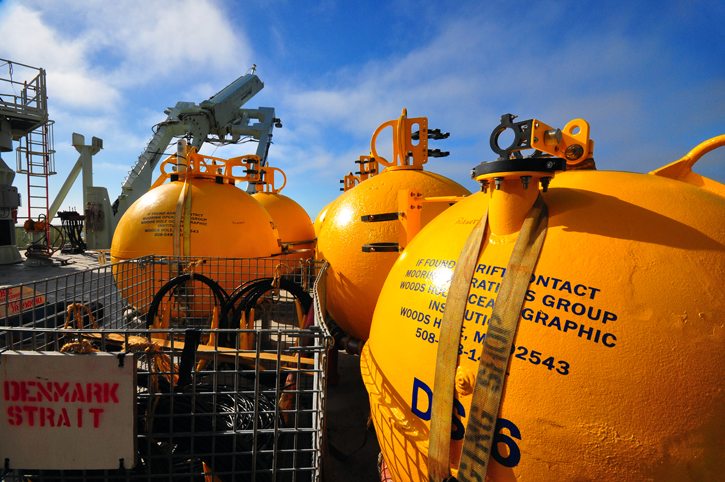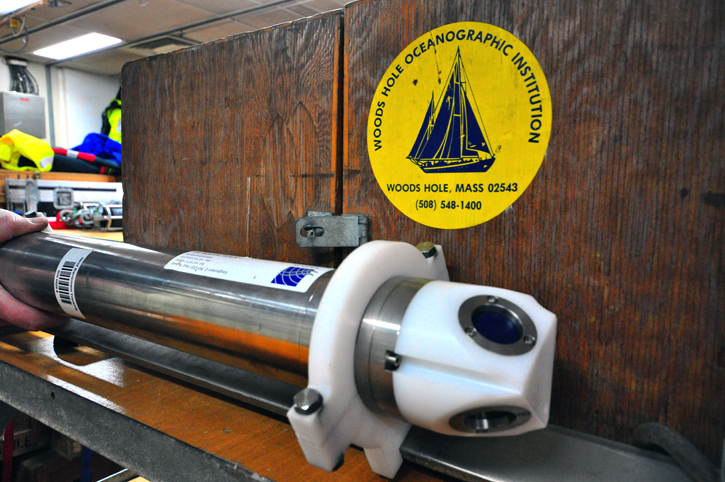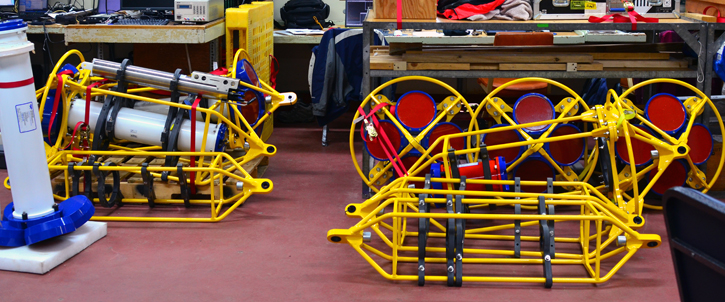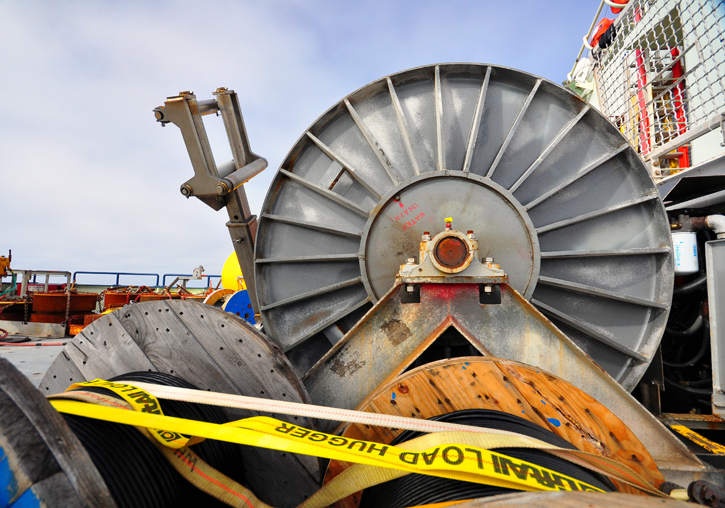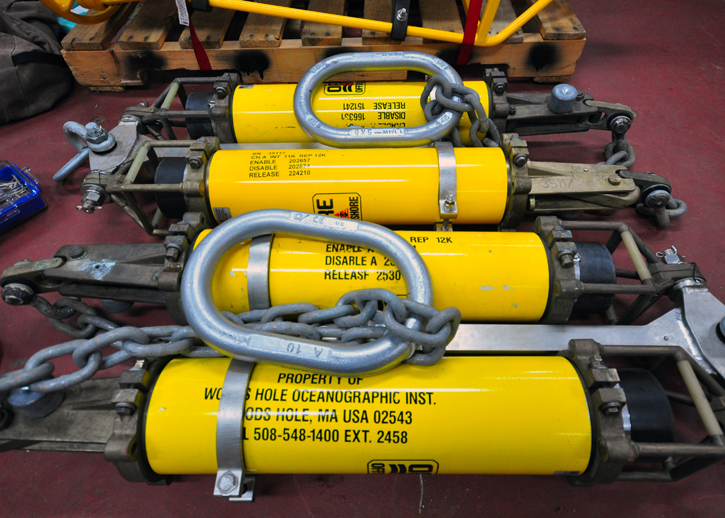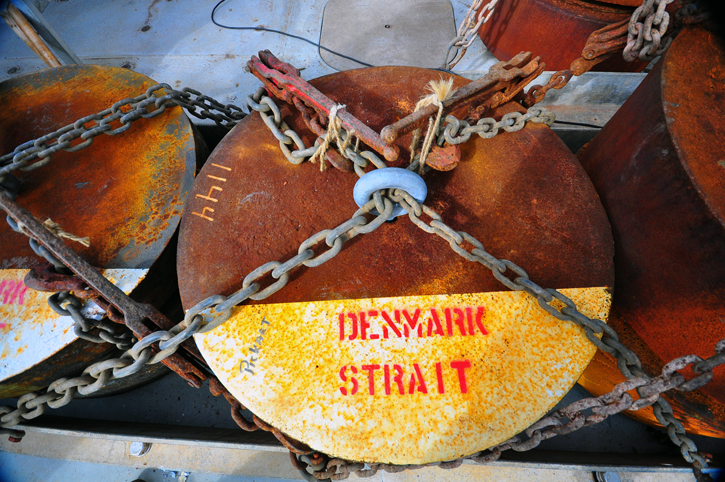August 23, 2011
There are two general methods to measure currents. You can release a device to float with the current, which then reports its position and transmits its data, usually via satellites, back to the ship or to a shoreside computer, the so-called Lagrangian, or float, method. Or, by the Eulerian method, you can fix the measuring device in one place to record data as the current passes the site. We might think of these two methods in cinemagraphic terms: Either you follow the action with the camera or plant the camera to record the action as it transpires. Moorings, fixed to the bottom, use the Eulerian method. As we said earlier, the basic structure of a mooring consists of the anchor, a powerfully buoyant ball near the surface, and a wire in between onto which instruments measuring, in this case, temperature, salinity, and velocity are attached. Let’s look first at those to measure velocity. The simplest, most straightforward is a miniature current meter. Currents rarely flow at consistent velocity throughout the water column, and to accommodate the inconsistency, scientists often attach an array of meters on the wire at predetermined depths. The Acoustic Doppler Current Profiler (ADCP) is another, more sophisticated, device to measure velocity. You’ve perhaps noticed the way the audible pitch of a fire-engine siren or locomotive changes as it approaches and passes, the so-called Doppler shift. The ADCP shoots pulses of sound waves into the water which, when they encounter particles such as sediment and plankton drifting with the current, bounce back at a slightly but measurably different frequency. From the difference, you can calculate the velocity of flow. ADCPs are usually mounted near the bottom of the wire “looking” up or near the top float looking down. Additionally, ADCPs are built into Knorr’s hull constantly pinging the water throughout the cruise, and when you factor out the ship’s speed and heading, you have current velocity. You acquire by that means a useful record of current during the ship’s passing. However, currents vary widely in velocity over time, so the shipboard ADCPs cannot substitute for those mounted on moorings, which typically remain in the water during their work for a year and more. Also, shipboard ADCPs are limited in range to about 400 meters. The moorings are specially designed for this cruise by John Kemp at WHOI (he and Jim Ryder, says Chief Scientist Bob Pickart, are among the best mooring technicians in the business). The specific design depends on the scientific objectives and the geographic locale. One of the most basic design concerns is the depth of the water in which the mooring is deployed. You see, the top float must remain 100 meters or so beneath the surface to keep it safe from waves, passing ships, and, in these waters, ice. During the first cruise I participated in, I couldn’t figure out how you recover a mooring, if the float is fixed that far beneath the surface until someone showed me the “acoustic release.” This clever device is attached to the wire at the very bottom near the anchor. When the time comes to retrieve the mooring to collect its stored data and change batteries, a technician “talks” to the release in an acoustic code from a portable computer called the “deck box.” The release responds in code, saying essentially, I’m awake and ready for instructions. The next code tells it to let go, the jaws that connect it to the anchor open, and the mooring—minus the anchor—floats to the surface to be retrieved and brought aboard. Scientists usually mount an upward-looking ADCP on the top float to cover those first 100 meters. Also as mentioned earlier, during this trip the techs and scientists will, for the first time, lay strings of moorings across the entire Denmark Strait, and so there is still much more to discuss about mooring-mounted instruments generally and these specifically. We’ve not yet touched on the means of measuring temperature and salinity, nor on the importance of doing so in these special waters, but let’s hold that for another time, perhaps tomorrow when mooring operations get into full swing. Before we stop, however, let’s point out the probably obvious fact that this purpose-built oceanographic gear is esoteric, very expensive—and, perhaps less obviously, highly vulnerable to loss. There’s a saying in the business that when you put instruments in the water, you no longer own them; the ocean does, and it may or may not give them back. Or expressed differently, “If you can’t afford to lose it, don’t put it over the side.” We were asked by German oceanographers to try to retrieve a mooring they had deployed in this area a year or so ago. Their acoustic release had responded to the wake-up call, but didn’t let go. They had tried dragging for it with grappling hooks, but to no avail, and had to leave it behind. So they supplied the release code, and asked us to give it a last try. No one aboard here gave it much hope, but we dutifully steamed to the position and talked to the release. Sure enough, it responded, but still refused to relinquish its hold. That mooring is gone probably forever, many thousands of euros lost, not to mention the valuable data it had been collecting and will continue to collect until the batteries expire. But that’s how it goes. Everyone hates to lose stuff, but everyone expects to. Last updated: December 27, 2011 | |||||||||||||||||||||||
Copyright ©2007 Woods Hole Oceanographic Institution, All Rights Reserved, Privacy Policy. | |||||||||||||||||||||||


